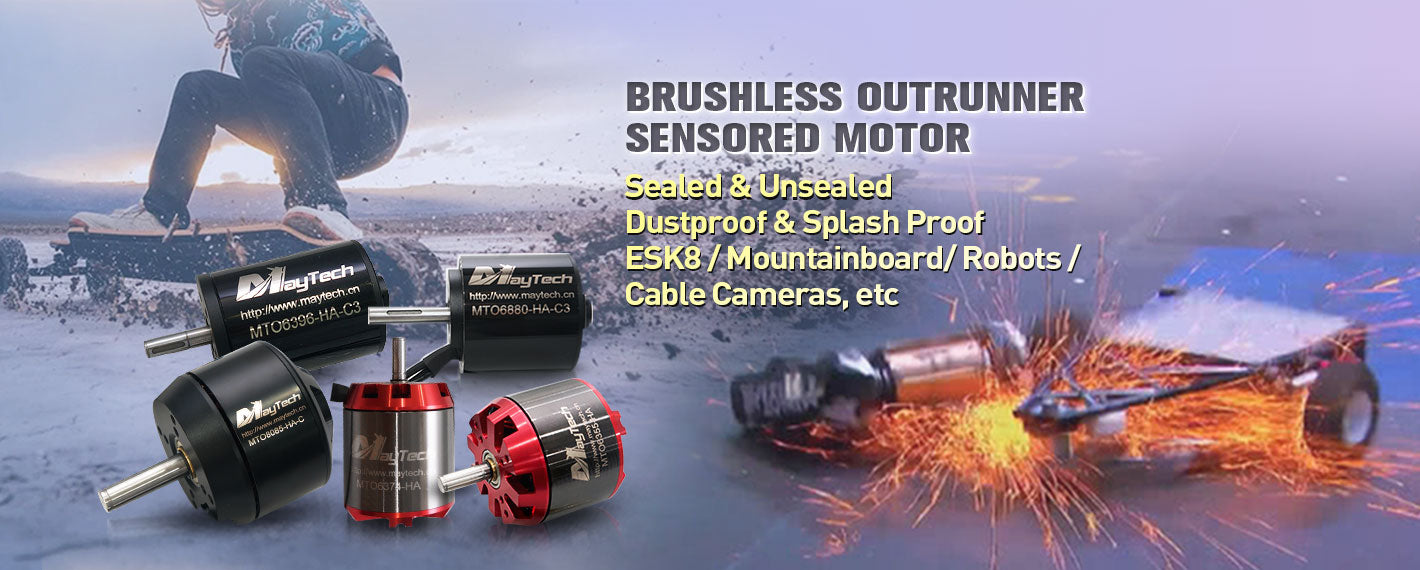- What is brushless motor?
A brushless DC electric motor (BLDC motor or BL motor), also known as electronically commutated motor (ECM or EC motor) and synchronous DC motors, are synchronous motors powered by direct current (DC) electricity via an inverter or switching power supply which produces electricity in the form of alternating current (AC) to drive each phase of the motor via a closed loop controller. The controller provides pulses of current to the motor windings that control the speed and torque of the motor.
The construction of a brushless motor system is typically similar to a permanent magnet synchronous motor (PMSM), but can also be a switched reluctance motor, or an induction (asynchronous) motor. They may also use neodymium magnets and be outrunners (the stator is surrounded by the rotor) or inrunners (the rotor is surrounded by the stator).
Brushless DC motors are more efficient, require less maintenance, generate less noise, and have higher power density than brushed DC motors.
2. What is KV? kilovolt
Answer: “Kv” refers to the constant velocity of a motor (not to be confused with “kV,” the abbreviation for kilovolt). It is measured by the number of revolutions per minute (rpm) that a motor turns when 1V (one volt) is applied with no load attached to that motor.
3. Brushless Inrunner vs Outrunner Motor
Outrunner: The permanent magnets on the outrunner are placed on the rotor and the rotor spins on the outside case. On the inside of the motor are the stator windings which do not rotate, they are fixed in position.
For example:
Inrunner: On the outer side of the motor is the case. The case in this situation does not rotate and is fixed. The stator windings are placed on the inside face of the case. When you spin the motor shaft of an inrunner, you are spinning the rotor which also contains the permanent magnets much like the outrunner. The difference of course being that they are now at the center of the motor.
Performance Differences
For simplicity, let’s loosely consider motors of equal size and weight in order to compare the possible performance differences.
|
Parameter for comparison |
Inrunner |
Outrunner |
|
Can Diameter |
Smaller |
Larger |
|
Can Length |
Larger |
Smaller |
|
RPM per Volt |
Higher |
Lower |
|
Motor power |
Lower |
Higher |
|
Torque |
Lower Torque |
Higher Torque |
|
Efficiency |
Best |
|
|
Heat Dissipation |
Best |
- Brushless Sensored vs Sensorless motor
Sensorless motors simply do not have sensors inside the motor—hence the name sensorless. They determine the likely position of the rotor based on feedback called back-EMF. EMF is short for Electromotive Force. Back-EMF also known as counter-EMF is essentially the resistance or voltage pushing back against the current flowing to the motor.
Sensors are not required as is evident by the fact that sensorless motors work, but sensors do perform a valuable function. When the speed control knows the rotors specific location, it can better control throttle feel. This is noticed in a smooth controllable throttle feel and the motor that doesn’t hesitate at low speeds. Sensored motor also has more startup torque or power off the line.
5. How to select suitable motors?
|
Application |
Motor Choice |
|
RC Airplane |
|
|
RC Helicopter |
|
|
Drone or Quadcopters, Hexacopters, Octacopters |
|
|
RC Car |
Inrunner or outrunner |
|
Electric surfboard, Efoil, Electric Boat |
|
|
Electric skateboard, E-bikes, cablecameras, go-karts, etc |
Outrunner |
|
Robotics |
Inrunner or outrunner |
There are several characteristics that you need pay attention to when selecting a motor but voltage, current, torque, and velocity (RPM) are most important.
Current is what powers the motor and too much current will damage the motor. For DC motors, operating and stall current are important. Operating current is the average amount of current the motor is expected to draw under typical torque. Stall current applies enough torque for the motor to run at stall speed, or 0RPM. This is the maximum amount of current the motor should be able to draw, as well as the maximum power when multiplied by the rated voltage. Heat sinks are important are constantly running the motor or are running it at higher than the rated voltage in order to keep the coils from melting.
Voltage is used to keep net current flowing in one direction and to overcome back current. The higher the voltage, the higher the torque. The voltage rating of a DC motor indicates the most efficient voltage while running. Be sure to apply the recommended voltage. If you apply too few volts, the motor will not work, whereas too many volts can short windings resulting in power loss or complete destruction.
Operating and stall values also need to be considered with torque. Operating torque is the amount of torque the motor was designed to give and stall torque is the amount of torque produced when power is applied from stall speed. You should always look at the required operating torque, but some applications will require you to know how far you can push the motor. For example, with a wheeled robot, good torque equals good acceleration but you must make sure the stall torque is strong enough to lift the weight of the robot. In this instance, torque is more important than speed.
Velocity, or speed (RPM), can be complex regarding motors. The general rule is that motors run most efficiently at the highest speeds but it is not always possible if gearing is required. Adding gears will reduce the efficiency of the motor, so take into account speed and torque reduction as well.
6. For Electric skateboard, Efoil, Electric surfboards, how to choose motors and ESCs?
Please refer to blog: What is a speed controller and what does it do? Beginner’s guide to choose the suitable controller for your electric-skateboard/electric surfboard



